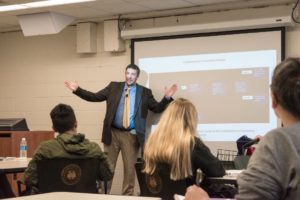Faculty presentation prepares students for Constitutional Convention
Richard Decker
Staff Writer

“Shall there be a convention to revise the constitution and amend the same?”
This question, raised by the New York State Board of Elections, has engrossed the nation. On Wednesday, Oct. 18, professors Robert Whitaker and Alan Joseph presented “The New York State 2017 Constitutional Convention Question,” an original 50-minute lecture.
The goal was to help inform students about this question, which will be included on New York State voters’ ballots in November.
The presentation was divided in two parts. First, Alan discussed the importance of Constitutional Conventions, their history in New York State and the process in which the State had come to this vote.
“The process begins on Nov. 7, and if you go to vote you will see a question on the ballot asking if you are in favor of calling a Constitutional Convention,” Whitaker said.
In the second half, Whitaker discussed what will happen as of Nov. 7 and the possible outcomes and implications of a convention. The pair would later delve into arguments both for and against a convention in New York.
“Thomas Jefferson once wrote ‘an informed citizenry is at the heart of a dynamic democracy,’” Joseph said. “We are here today to learn about this issue of the New York Constitution and whether there should be a convention to amend it.”
Joseph explained the importance of distinguishing that a state constitution cannot strip citizens of the rights guaranteed to them by the federal constitution.
The arguments both for and against the convention involve the delegates voting and the potential effect on citizens’ rights. Both Alan and Whitaker discussed the process of the delegate selection, illustrating that a delegation consists of the top three vote-getters in each Senate district and 15 at-large statewide delegates, for a total of 204.
“[Some believe] this is going to be dominated by political insiders, elected officials and possibly seated state lawmakers,” stated Whitaker.
Joseph and Whitaker both considered the argument that a convention could strip New York citizens of their rights. Alan’s case study cited state conventions that occurred in the 19th century.
“Not only once, but twice, state conventions first restricted and then completely took away the rights of African-Americans in New York State,” Joseph said.
New York has had four Constitutions — 1777, 1821, 1846 and 1894. The Constitution of 1894 established a clause “requiring that every 20 years, this question appear on the statewide ballot,” Alan said.
Whitaker then explained the multi-year process of the Constitutional Convention.
If the state votes against the convention, as in 1977 and 1997, the process is over. However, if the ruling majority is in favor, the state will then begin a two-year process. Whitaker explained that process, saying “a year from now, Nov. 6, 2018, the voters will elect the delegates, or the people who will participate in the convention,” Whitaker said.
The next step in the process will occur in April of 2018 when the elected delegates will convene in Albany to propose amendments to be sent to the ballot.
“During this time, the legislature will pass laws appropriating funds for the convention,” Whitaker said. He also noted that the convention’s cost, another concern of critics, could range from $50 million-$350 million.
On Nov. 5, 2019, voters will return to the ballot box to vote on the amendments or entirely new constitution proposed by the convention. If the people of New York vote in favor of the amendments or new constitution, it will take effect in January of 2020, where the process will conclude.
Any registered voter in New York State can vote for or against the Constitutional Convention at their local voting center on Nov. 7, 2017. The Viking Video Technologies recording is available to students, faculty, and staff via Blackboard and on the official Viking Video YouTube channel at https://youtu.be/V5H52xBkNW0.
